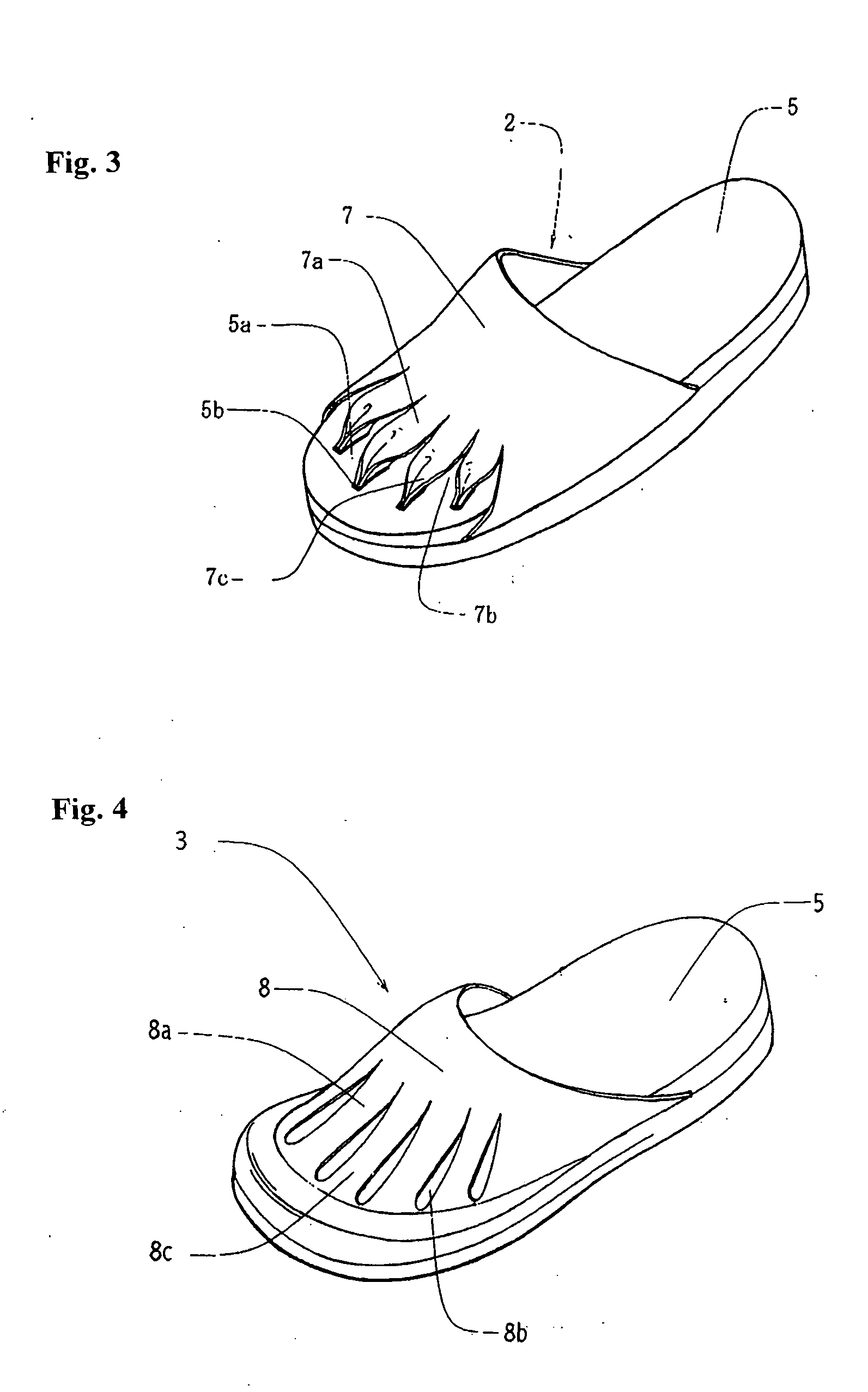Footgear
a technology for shoes and feet, applied in the field of shoes, can solve the problems of not finding shoes that fit the feet exactly, people cannot walk normally, and people cannot find shoes that fit the feet, and achieve the effect of facilitating the putting on of shoes
- Summary
- Abstract
- Description
- Claims
- Application Information
AI Technical Summary
Benefits of technology
Problems solved by technology
Method used
Image
Examples
first embodiment
[0062] With the invention of the first embodiment, the straps 6c are formed in a twisting shape. Thus the notches serve as openings 6b and in a state where the position of foot and footwear 1 relative to each other is flexibly maintained by the instep cover 6, the twisting shape surface serves as guide, leading toe tips to the openings 6b. Further, the straps 6c are made long, facilitating the putting on of footwear.
[0063] When the footwear 1 of the first embodiment is to be put on, it is put on so that five toes 9 (namely, big first toe 9a, second toe 9b, third toe 9c, fourth toe 9d, and fifth toe 9e) individually protrude from the respective openings 6b of the instep cover 6. In this way, a foot is flexibly held by the instep cover 6, and the four straps 6c are respectively sandwiched by adjacent pairs of the five toes 9. Because the top part of the straps 6c can be folded into a V-shape and the top parts of the straps 6c folded into V-shapes grip the toes 9, the foot and footwear...
second embodiment
[0070] The invention of the second embodiment is configured such that the straps 7c are formed folded in a V-shape, thereby providing openings 7b that gradually widen in the toe tip direction between the straps 7c. In a state where the position of foot and footwear 2 relative to each other is flexibly maintained by the instep cover 7, the surfaces of the straps 7c serve as a guide, leading the tips of the toes 9 to the openings 7b. Further, the straps 7c are made long, facilitating the putting on of the footwear.
[0071] The method of putting on the footwear 2 and the effects of the second embodiment are as set forth in the description of the first embodiment.
[0072] The third embodiment of the present invention will be explained with reference to FIG. 4. A footwear 3 of the third embodiment comprises a sole 5 and an instep cover 8.
[0073] On a toe tip part 8a of an instep cover 8, at positions corresponding to the respective five toes, five teardrop-shaped holes 8b are provided. The ...
third embodiment
[0074] The invention of the third embodiment is configured such that holes 8b that gradually widen in the tip toe direction are provided, and in a state where the position of foot and footwear 3 relative to each other is flexibly maintained by the instep cover 8, the tips of toes 9 are guided to the holes 8b. Further, straps 8c are made long, facilitating the putting on of the footwear.
[0075] The method of putting on the footwear 3 and the effects of the second embodiment are as set forth in the description of the first embodiment.
PUM
 Login to View More
Login to View More Abstract
Description
Claims
Application Information
 Login to View More
Login to View More - R&D
- Intellectual Property
- Life Sciences
- Materials
- Tech Scout
- Unparalleled Data Quality
- Higher Quality Content
- 60% Fewer Hallucinations
Browse by: Latest US Patents, China's latest patents, Technical Efficacy Thesaurus, Application Domain, Technology Topic, Popular Technical Reports.
© 2025 PatSnap. All rights reserved.Legal|Privacy policy|Modern Slavery Act Transparency Statement|Sitemap|About US| Contact US: help@patsnap.com



